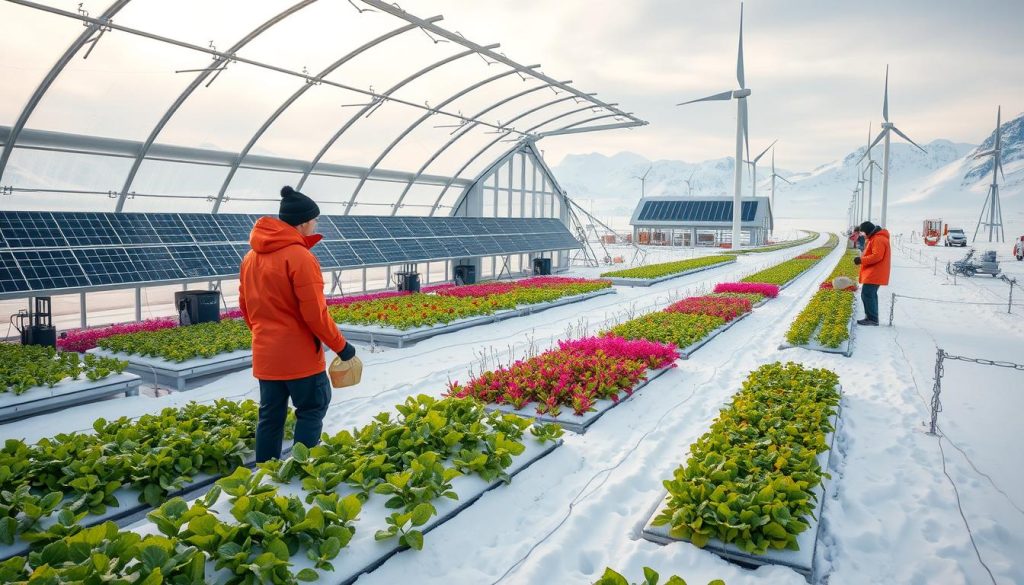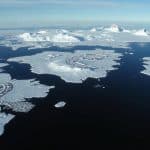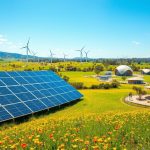Today, as we face climate change, Antarctica offers both challenges and chances for new businesses. The harsh polar conditions require eco-friendly ventures. They must protect the ecosystem while promoting economic growth.
This piece looks at polar business ideas. It focuses on using innovation and tech to succeed in Earth’s fragile environment.
Understanding Antarctica’s Unique Environmental Challenges
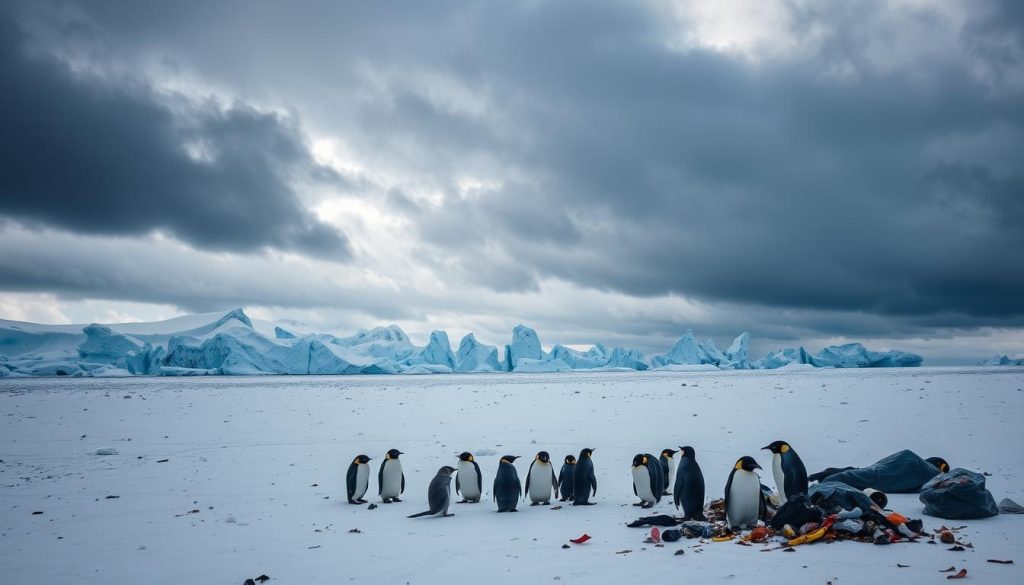
Antarctica is up against big environmental issues. Extreme cold and unpredictable weather hurt its ice and living creatures. The ice melting shows how global warming is making temperatures rise.
Wildlife like polar bears, penguins, and seals are losing their homes due to less ice. This makes finding food and raising young harder. It’s important for experts and leaders to understand this to save these animals.
Protecting Antarctica’s nature is critical for the whole planet. The way everything in Antarctica is connected shows why we must care. By choosing sustainable ways to work, we can keep this beautiful place safe for all.
The Importance of Sustainable Ventures in Polar Regions
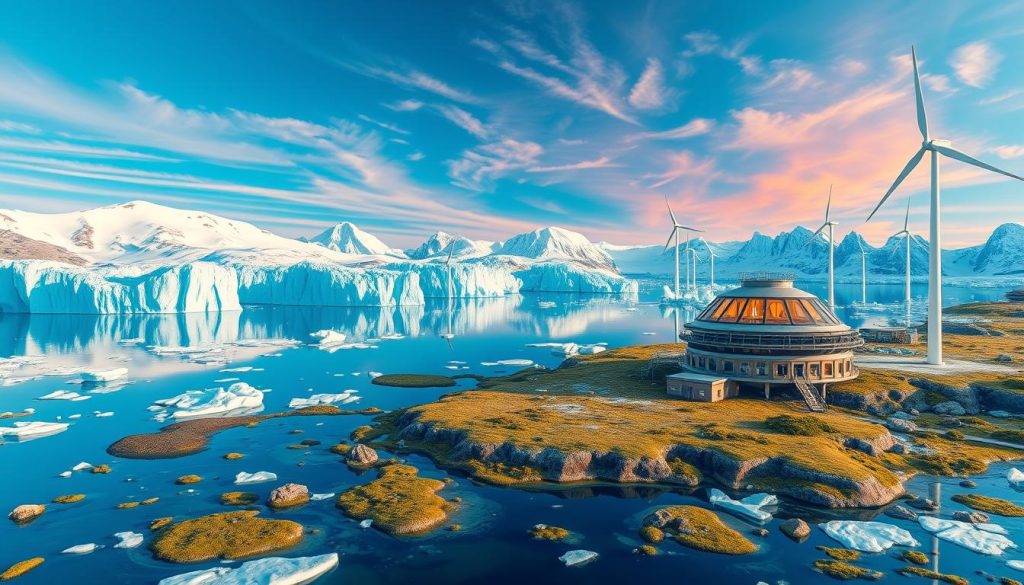
Sustainable ventures in polar areas are key to tackling the environmental issues they face. They help deal with the rising threats of climate change. By staying sustainable, businesses reduce their environmental harm, conserve resources, and keep the ecosystem balanced.
At the poles, entrepreneurship is key in fighting climate change. It brings in new ideas that help the environment and make money at the same time. Looking at how renewable energy helps Arctic communities can guide those in Antarctica.
Going green has economic pluses too. It creates jobs and boosts local economies, all while cutting down on CO2 emissions. By being eco-friendly in polar areas, we protect the environment for the future. This way, the next generations can also witness the untouched beauty and rich wildlife of these places.
Innovative Business Ideas for Antarctica’s Unique Environment
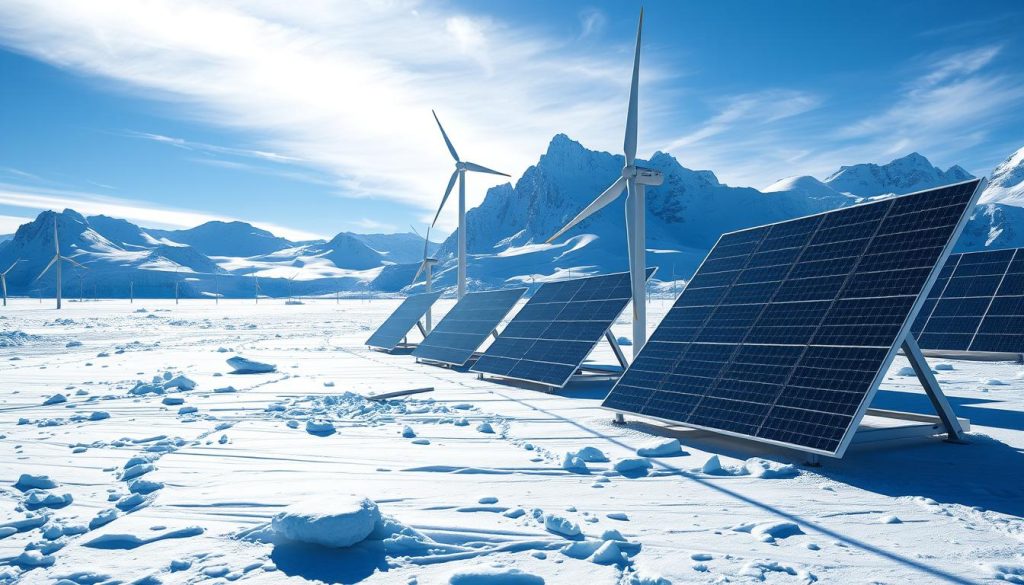
Exploring new business ideas for Antarctica involves renewable energy and good waste management. These approaches are crucial for reducing harm to the environment. They also drive sustainable progress in this delicate area.
Utilising Renewable Energy Sources
Using renewable energy like solar and wind power is key in Antarctica. It lessens the need for fossil fuels and helps fight climate change. Pilot projects in other cold areas show we can do this in Antarctica too.
Innovative Waste Management Solutions
Managing waste well is important to keep Antarctica clean. New recycling tech and biodegradable materials cut down bad effects of human presence. These methods lead to a greener, more careful way to handle waste in this special place.
Tourism Opportunities in the Last Frontier

Antarctic tourism is becoming very popular. Adventurers and nature lovers are going there for unique experiences. This is because people are now more interested in eco-tourism. It’s important to keep tourism sustainable to protect Antarctica’s special ecosystem.
Tour operators are key in creating responsible tourism. They do this by providing tours that don’t harm the environment. These tours also teach visitors about the environmental issues in Antarctica. They help people see the beauty and vulnerability of the place. This encourages visitors to look after the environment.
- Adventurous close encounters with wildlife, including penguins and seals, where guidelines are enforced to minimise disturbance.
- Opportunities for scientific excursions, enabling tourists to engage directly with research and conservation efforts.
- Cultural exchanges that educate visitors on the history and significance of the indigenous practices and scientific work in the region.
Eco-tourism in Antarctica has been successful. Companies that use sustainable practices show it’s possible to enjoy visits without harming the environment. As more people want to visit Antarctica, keeping a balance between enjoying it and preserving it is crucial for the future of this amazing place.
Research and Development: Pushing the Boundaries of Knowledge
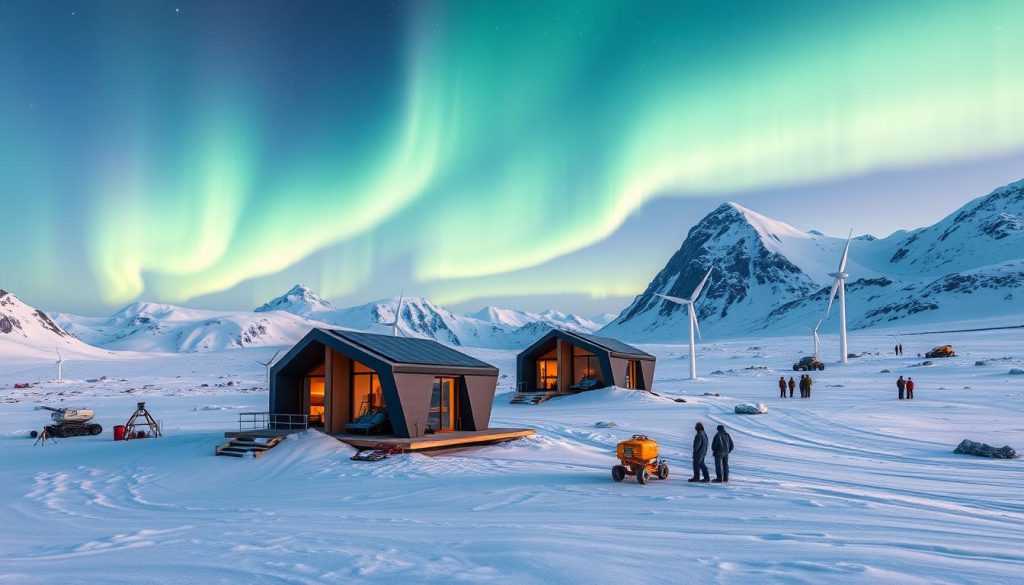
Antarctica’s pristine but challenging environment calls for key research and development. It helps us understand polar ecosystems better. Businesses and research institutions around the world join hands here. They create solutions for pressing environmental problems. This teamwork boosts Antarctic research and supports sustainable actions for our planet.
Collaboration with Global Research Institutions
Working with worldwide research institutions is crucial. It allows for the sharing of vital knowledge. These collaborations can lead to new breakthroughs. They improve research methods and technologies. Key advantages include:
- Access to top-notch scientific tools.
- Sharing expertise that fosters innovation.
- Better funding options for detailed studies.
Creating Research-Focused Eco-Cabins
Eco-cabins in Antarctica are designed for researchers’ specific needs. They set an example for sustainable building. Using energy-efficient designs and local materials, they have a small environmental impact. They also use renewable power, like solar. This shows how important being eco-friendly is, even in remote areas.
Eco-Friendly Transportation Solutions

Travel in Antarctica faces unique challenges, especially in transport. Eco-friendly options are crucial for sustainable journeys in this delicate region. Electric and hybrid vehicles are key, lowering emissions significantly. They’re part of a larger effort to reduce our environmental impact.
Electric and Hybrid Vehicles for Sustainable Travel
Electric vehicles have changed the game in Antarctica. They’re silent and efficient, perfect for its sensitive ecosystems. They cut down air pollution and greenhouse gases. Plus, they open doors for new innovations. But, cold temperatures are a hurdle. Yet, battery tech and vehicle designs are improving.
- Reduced emissions lead to cleaner air.
- Electric vehicles work with renewable energies, like solar.
- Hybrid vehicles use power more flexibly, extending their range.
Investing in eco-friendly transport benefits us now and sets a sustainable standard for polar exploration. With ongoing tech improvements, adapting these methods is vital. It helps protect the environment while supporting science and tourism in Antarctica.
Agriculture in Extreme Conditions: Vertical Farms
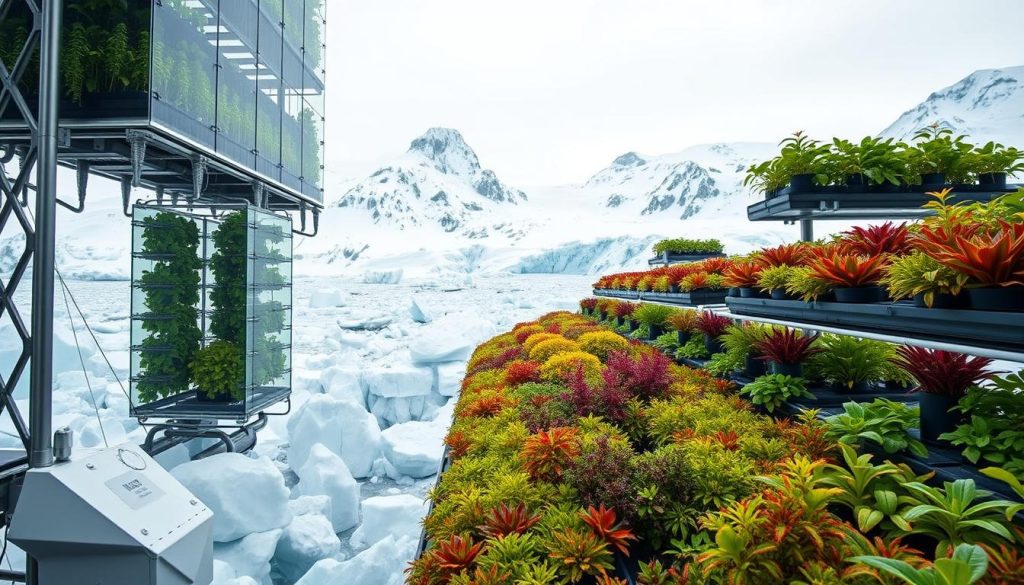
Antarctic agriculture faces unique challenges and opportunities due to rising demands for sustainable food. Vertical farming offers a practical solution. It uses methods like hydroponics and aeroponics, allowing crops to grow in tight spaces. This approach uses less land and tackles the tough Antarctic conditions.
Hydroponics and Aeroponics for Food Security
Hydroponics lets plants grow in nutrient-rich water instead of soil. Aeroponics improves on this by hanging plants in the air, with roots misted with nutrients. These advancements are key for food security for both researchers and tourists. Trials in extreme climates have already successfully grown crops.
- Effective use of water resources.
- Reduced footprint compared to traditional methods.
- Year-round production capabilities.
These methods support those living and working in Antarctica and can teach us about sustainable food systems globally.
The Role of Technology in Antarctic Business Innovations
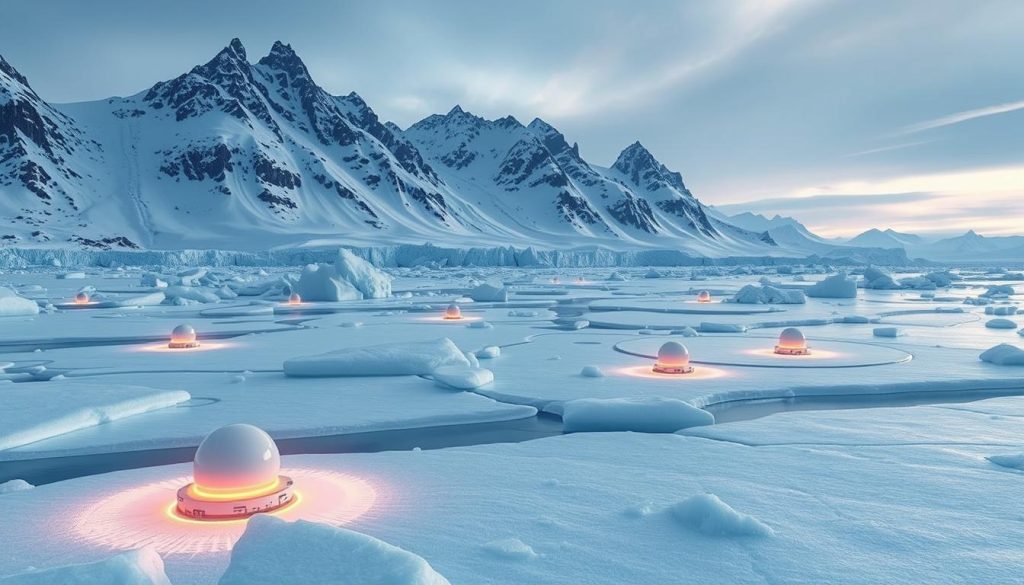
Technological advances greatly shape business innovations in Antarctica. Smart sensors for monitoring the environment are key. They collect data on climate changes and the health of the ecosystem. This is crucial as businesses aim for sustainability whilst operating in Antarctica.
Smart Sensors for Environmental Monitoring
Smart sensors have the power to watch the environment round-the-clock. They track temperature changes, ice melting, and animals. This is crucial for both researchers and businesses. The collected data supports:
- In making smart decisions on using resources.
- Spotting trends and dangers to Antarctica’s unique ecosystem.
- Improving how businesses work in harmony with nature.
Companies like IBM and Microsoft are at the forefront, using smart sensors to analyze data. This gives those in the region reliable, useful insights. Such tech not only helps in monitoring but also opens up new business paths. It promotes both economic and environmental progress in Antarctica.
Innovative Packaging Solutions for Remote Supply Chains

Antarctica’s supply chains face special challenges because of its extreme conditions. Businesses there need to be mindful of the environment. Sustainable packaging is key for these companies to work well without harming our planet. It makes shipping more efficient and cuts down on waste, which is hard to dispose of there.
Biodegradable packaging materials help reduce the environmental impact of shipping. They naturally decompose, avoiding harm to untouched ecosystems. By using such materials, businesses show their dedication to protecting nature.
Reusable containers are another smart way to keep remote supply chains efficient. These containers can be used many times, which lowers the need for disposable packaging. This lessens waste and supports a circular economy through returnable systems.
To meet Antarctica’s packaging needs, companies must think out of the box. Sustainable packaging choices enable them to handle remote supply challenges. At the same time, they take care of the environment.
Cold-Climate Clothing and Equipment Production
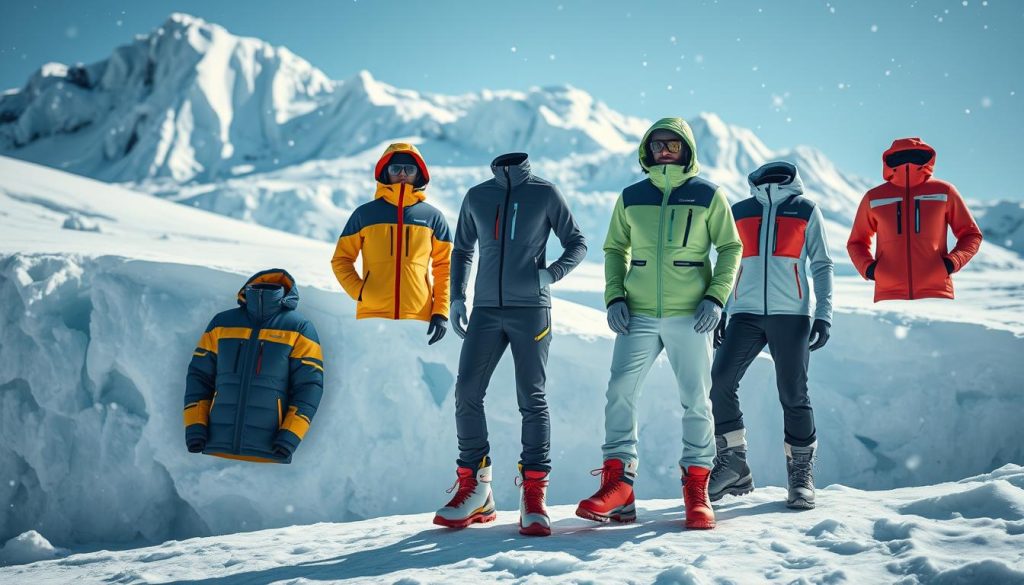
Creating clothing for cold climates, such as Antarctica, needs careful thought on functionality and sustainability. Companies stepping into this field must tackle not only severe weather challenges but also consider the ethics of how they make their products. Using sustainable methods can give them an advantage in a market that cares more about the planet now.
Innovative materials and new technologies are essential in making effective cold-weather clothes. Successful cold-climate gear has certain important features:
- Insulation properties to keep warmth in extreme cold.
- Waterproof and breathable fabrics for managing moisture and sweat.
- Lightweight materials for easy movement without losing warmth.
Top brands are leading the way in making gear for the cold of Antarctica, showing new improvements in technical clothing and equipment. They use recycled materials and resources from nature in their production. This does not only meet the growing customer demand for eco-friendly products but also helps local communities. With ongoing exploration in Antarctica, the emphasis on advanced cold-climate apparel will set the stage for future innovations that improve both performance and care for the environment.
Marine Entrepreneurship: Sustainable Fishing Practices

Marine entrepreneurship is key in promoting sustainable fishing in Antarctica. This method focuses not only on using sea resources but also on keeping our oceans balanced. By adopting sustainable fishing, we help protect marine life and support local economies.
Balancing Ecology with Commerce
To succeed in Antarctica, marine entrepreneurs must find a middle ground between protecting nature and making a profit. Using sustainable fishing methods shows we can use ocean resources wisely. We achieve this balance by sticking to fishing limits, using technology to track fish, adopting fishing methods that protect sea life, and involving local communities in fishing decisions.
- Adherence to strict quotas to prevent overfishing.
- Utilisation of advanced technology for monitoring fish populations.
- Implementing eco-friendly catch methods to reduce bycatch.
- Engaging local communities in decision-making processes regarding fishing practices.
Studies prove sustainable fishing benefits both the ecosystem and business. It leads to healthy seas and successful companies. Through thorough impact studies, we can make rules that guard the ocean while allowing safe fishing.
Cultural Preservation and Antarctic Indigenous Practices
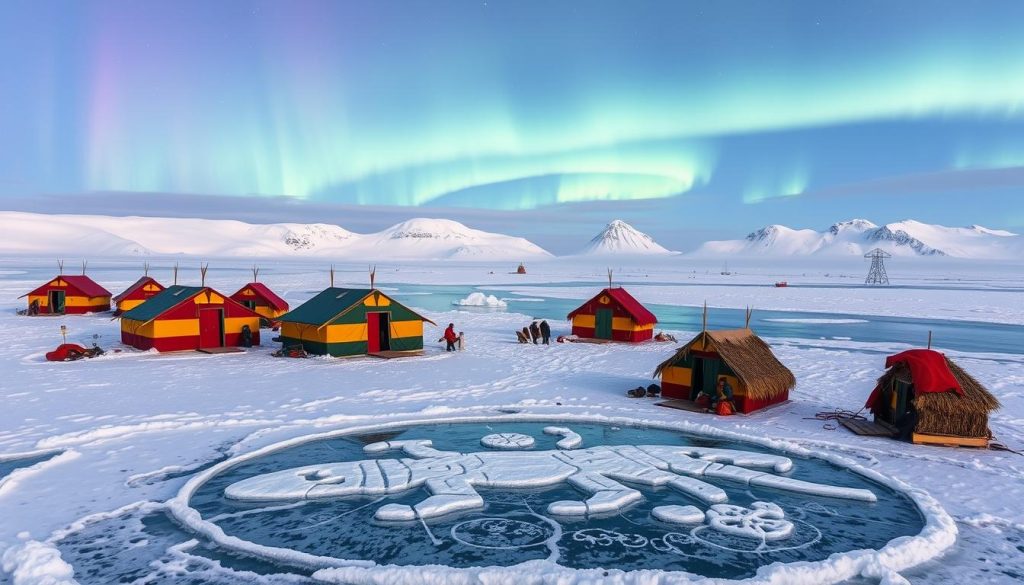
Keeping Indigenous traditions alive in Antarctica is essential. The extreme cold and environment demand special care in business, always respecting local ways. Every move should aim to protect and honour these ancient cultures.
To protect these cultures effectively, companies can:
- Work closely with Indigenous groups to understand their ways.
- Use local wisdom to make businesses greener and more sustainable.
- Teach their team and guests why it’s vital to respect Indigenous customs.
This approach helps everyone value Antarctic heritage more. It also guides ethical business actions in this delicate area. As business grows here, keeping culture in mind is key.
Developing Communication Infrastructure in Remote Areas
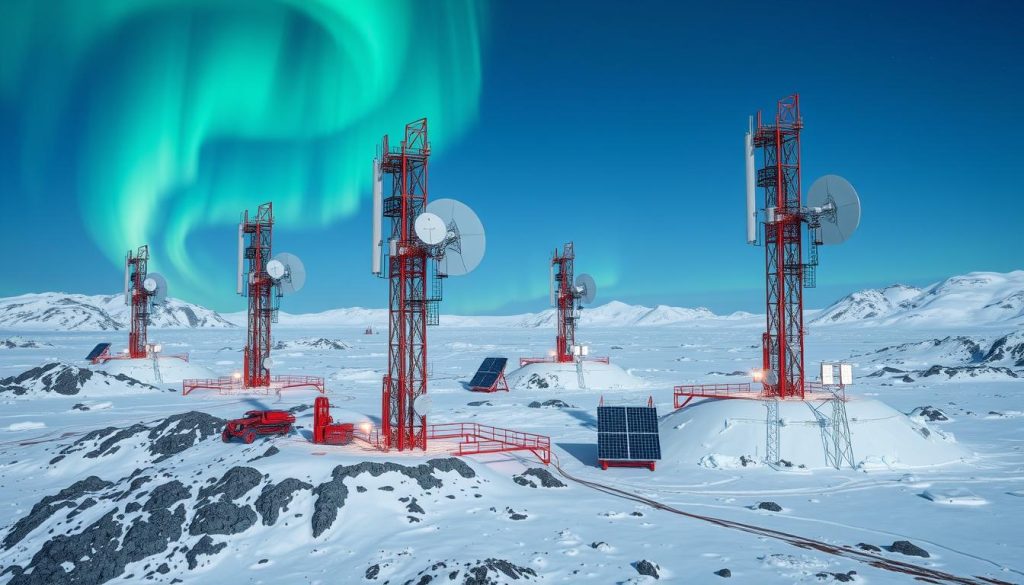
Setting up dependable communication in remote Antarctic areas supports business ventures. The freezing conditions make connectivity tough. So, finding new ways to keep in touch is key. This requires using the latest technologies.
Satellite tech is key for good communication networks in isolated spots. It connects remote teams with the world by allowing:
- Real-time data transmission.
- Improved collaboration among researchers and entrepreneurs.
- Streamlined logistics and supply chain management.
Mobile systems and internet satellites also boost infrastructure. They change how businesses work in these places by enabling:
- Enhanced safety and emergency response communications.
- Access to digital resources and global networks.
- Support for innovative projects and research initiatives.
By focusing on better communication networks, Antarctic ventures can succeed. This ensures sustainable practices while tackling the area’s unique challenges.
Climate Change Adaptation Services
Antarctica is undergoing massive environmental changes. Developing climate change adaptation services is crucial to help local businesses and communities. These services offer strategies for resilience. They give organisations tools to assess risks and make needed adjustments to their operations. This is vital as the landscape changes quickly.
By using adaptive planning, Antarctic businesses can better handle climate fluctuations. This not only supports sustainability but also promotes environmental stewardship. It’s a step towards safeguarding their future while caring for our planet.
Businesses, scientists, and policy-makers need to work together. This partnership is key to creating effective resilience strategies. It combines scientific discoveries with sustainable regulations. This approach helps businesses stay informed and compliant.
Through teamwork, integrating climate change adaptation can build a strong framework. This framework supports long-term success amid climate challenges. It shows how collaboration is essential for sustainable economic growth.
Ongoing support through training and resources is also crucial. It empowers local enterprises to make necessary changes. Highlighting the value of climate change adaptation not only manages risks. It also fosters a culture of readiness and sustainability.
Thus, businesses in Antarctica play a big role in environmental responsibility. They stand strong in challenging times. This contributes to the global effort in tackling climate change.

